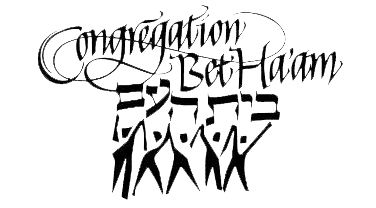by Toby Rosenberg, Congregant
Perhaps you are among the growing circle of worshippers who have gathered around the Bet Ha’am reflecting pool after Rosh Hashanah morning services to share a short liturgy then toss stones representing your flaws into the pool.
Or maybe you have, over the years, found a special spot by a body of moving water and made your own ritual, tossing bread crumbs or the lint long settled into the seams of your pockets. Maybe those crumbs reminded you of Passover chametz (leavened bread–which is not allowed during Passover). Maybe you remembered a few traditional words to say–such as Micah 7:19, the line which inspired the start of this tradition way back in the thirteenth century: “God will take us back in love; / God will cover up our iniquities, / God will hurl all our sins / Into the depths of the sea.”
Did you know that the thirteenth century rabbis were worried this physical expression of casting off sins might discourage the real work of t’shuvah (literally, “return”, as to the right path; more figuratively, to make atonement with self, others, and God)? Who could blame them? The Torah itself shows us the power of physical rituals through such stories as Miriam and the women dancing by the water’s edge after narrowly escaping Pharaoh.
Have you approached your water’s edge demurely or with trepidation, dropping or sprinkling your crumbs? Or have you dashed into the surf, flinging your sin-proxies with abandon, hoping some fish, some “scape-mackeral,” will carry your bread crumbs far or transform them into a beneficial part of the food chain? Did you bring traditional words as reminders that you are following an old practice, or did you meditate your own intentions?
And for those who have not yet tried the tashlikh (literally, “you will throw”) ritual, this is the perfect year to take it on. Some time after worship on the first day of Rosh Hashanah or even up until the last day of Sukkot, go to a flowing body of water. If that is not possible, a faucet or hose will do. Or put some water in a can, drop in your symbolic failings, and fling the water into the air.
Engage your family. Maybe your children will write missteps on stones to cast off. You could give your tashlikh practice a social justice theme this year. Perhaps you will make it a solo and very personal endeavor, shedding not only your shortcomings but your doubts and misgivings.
Sequestered in my Bet Ha’am classroom is a scrapbook of early 20th century Jewish ephemera These are the “toys,” the pop-out part of greeting cards from circa 1900. One of them shows small groups gathered for tashlikh in lower Manhattan with the Statue of Liberty in sight. I can only imagine the power of that moment for those immigrants.
Any way you choose to incorporate a tashlikh tradition into this holy season is likely to add meaning and a sense of empowerment during these isolating times. Try it.
For more information about tashlikh, here is an article from My Jewish Learning. And here are the familiar readings compiled by Rabbi Saks.

Water image by Chris Lawton on Unsplash.

